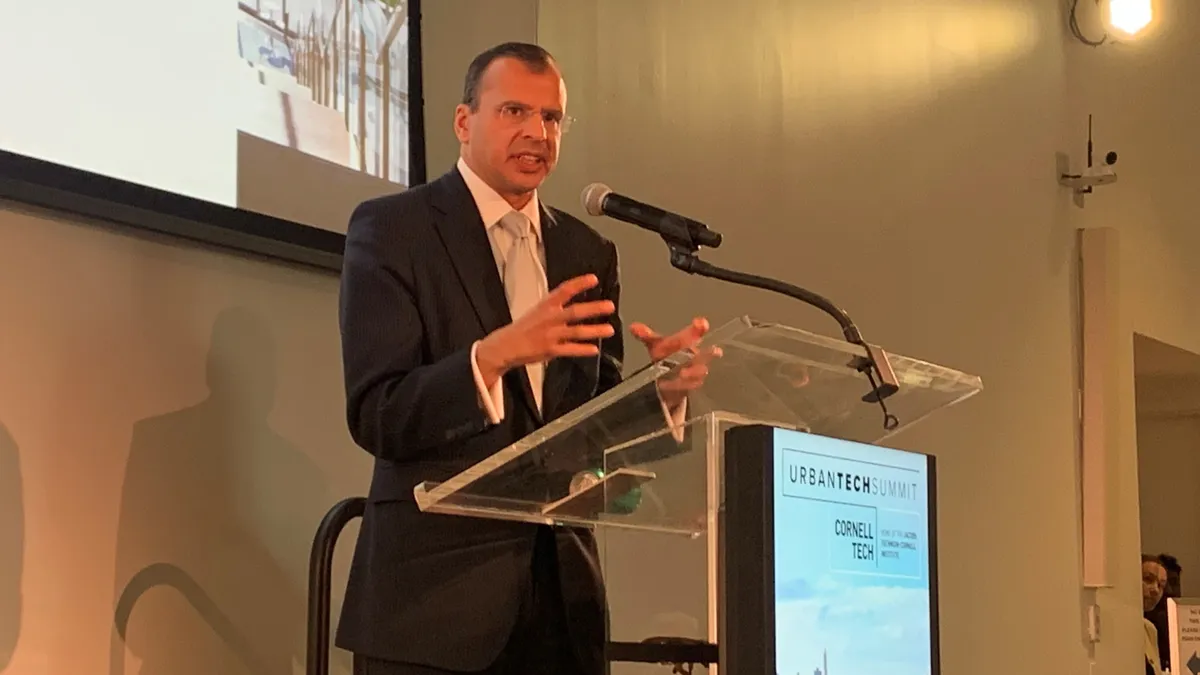City leaders don’t need artificial intelligence-driven technologies to tell them they have a climate change problem, at least in the eyes of Rohit Aggarwala, New York City’s chief climate officer.
“We don't need AI or big data to tell us with much greater detail how screwed we are as a city or as a planet,” Aggarwala said at last week’s Urban Tech Summit held at Cornell Tech’s Roosevelt Island campus in New York City.
Technology developers should instead focus on solving “the real problems that we face” in city government, which include engineering, project coordination and funding hurdles, said Aggarwala, who also serves as commissioner of the city’s Department of Environmental Protection.
Aggarwala detailed some of these “real problems” in his remarks. For example, New York City’s building decarbonization law, Local Law 97, is challenged by the multi-billion dollar price tag of retrofitting the city’s buildings and the poor management of many buildings.
“We've got a lot of bad management in a lot of our buildings, and we are asking them to do something that's really difficult and really ambitious,” Aggarwala said. “Right now, we're doing it in the face of interest rates that are really high.”
He also pointed to the engineering hurdles the city faced during work on the Champlain Hudson Power Express, a transmission project that will bring Canadian-generated clean energy to New York. The project developer’s initial design for infrastructure in the city was “absolutely unacceptable,” Aggarwala said, because it interfered with critical sewer infrastructure in the borough of Queens. The conflict underscores how the complexity and cost of doing underground construction in New York City can hold back the renewable energy transition, Aggarwala said.
Challenges like these are the “cutting-edge areas” for potential AI applications, Aggarwala explained.
“If you want to have AI address climate, I need to ask you to help it make government work better,” Aggarwala told the audience. “Particularly in those areas where government is already trying to address things, but it is not in the policy, it is not even necessarily in the money. It is in the way we do things.”
Aggarwala is hopeful that AI can address local governments’ operational challenges but said climate-related AI applications could fail to be useful to cities in the same way other urban technologies have been.
“We know that urban technology has fully conquered that age-old problem of ‘How can I get a burrito delivered?’ But it has not really addressed our housing crisis. It has not really fixed our transit systems,” Aggarwala said.
As AI tools proliferate, investments will be needed to teach the public sector how to use them, added Elijah Hutchinson, the executive director of the New York City Mayor's Office of Climate and Environmental Justice, in his remarks at the Urban Tech Summit.
“It's encouraging to hear all of the different ways in which AI can be useful,” Hutchinson said. “We really need AI to also work for government as well and to be brought along in this transition.” Types of technology he would like to see include tools that assess how bus and bike lanes impact vehicle travel times as well as tools that help the city monitor noise and air quality impacts, “which are often very difficult to measure and can be fleeting.”
However, the climate opportunities of AI must be balanced with the environmental harms the technology poses, Hutchinson said. Computationally intense models are driving surging demand for data centers, which use large amounts of land, energy and water. Hutchinson noted that, on average, the water use of a data center for one day is equal to the water use of 3,000 New Yorkers.
“There is so much more we don’t know in this landscape,” Hutchinson said. “Like any tool, what can help us can also harm us, and it needs to be used carefully.”












